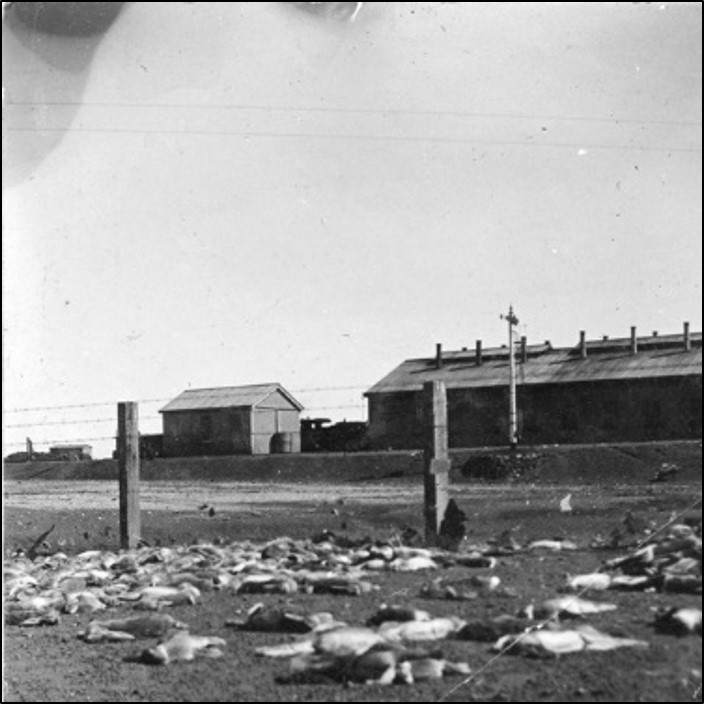
An extremely low water level in the Darling River in Wilcannia, 1902. Source: National Library of Australia
Australia is a continent defined by extremes. Recent years have seen devastating scenes of blistering heat, historic low rainfall and drought across central and eastern Australia.
But what can droughts tell us about the future? Ecologists have reconstructed Australia’s Federation Drought (1895 to 1903) to explore how megadroughts affect Australian ecosystems. They found that droughts could lead to a possible ecosystem collapse without any mitigation from us.
‘Once in a century’ drought
The Federation Drought is thought to be one of the most severe droughts in European recorded Australian history. Much of the country received less than 40 per cent of its average rainfall. 1902 was also our driest year on record.
“In NSW, most rivers stopped flowing. Dust storms filled dams, buried homesteads and created ghost towns as people fled,” said our lead researcher Dr Robert Godfree.
But little was known about the Federation Drought’s ecological impacts.
With the availability of recently digitised archival newspaper reports, ecologists reconstructed the events of the Federation Drought to measure its impact on biodiversity. They found that the Federation Drought had the biggest impact on plants and animals across the continent since records began.

Australian Rainfall Deciles from November 1901 to October 1902. Source: BOM
Mass loss
To reconstruct the Federation Drought, our scientists studied historical newspaper articles from the National Library of Australia.
“We overlaid this with historical rainfall records, and we travelled to the severely impacted areas. We were also able to refer to CSIRO’s National Research Collections Australia to determine what was impacted,” Dr Godfree said.
This allowed researchers to clearly visualise what conditions were like in 1902, and their effects on biodiversity.
“More than 60 bird, fish, mammal, reptile, and plant genera (species) were severely affected across over a third of Australia,” he said.
“Wildlife and stock starved or died of thirst. Native birds and mammals died under trees, in creeks, and on the plains. Tens of millions of sheep were killed. Hundreds of millions of rabbits died of starvation after stripping the landscape of its plant life,” he said.
“Herbivores, grain-eating birds, fish and plants were most vulnerable, while predators who could feed on dead animals, and other groups like waterbirds which could travel long distances, were less impacted,” Dr Godfree said.

A cow carcass close to the river. Many stock starved or died of thirst during the Federation Drought. Source: National Library of Australia
Changing landscape, changing climate
Australia’s national climate projections indicate that, over the coming decades, we will experience more time spent in drought. And researchers warn that an increase in such drought events could be devastating for global biodiversity.
“With many of Australia’s landscapes more fragmented and degraded than in the 1800s, and species under pressure from invasive plants and animals, a similar drought today could spell disaster on an even more devastating scale than seen in the Federation Drought,” Dr Godfree said.
“Right now we need to focus on maintaining healthy ecosystems as an insurance against drought impacts,” he said.
This is why we need a plan.

Hundreds of millions of rabbits died of starvation after the drought decimated the land of greenery. Source: National Library of Australia
Dealing with drought
But it’s not all doom and gloom. Our researchers are using this data to work on ways we can prepare for, and adapt to, the impacts of future droughts. This ranges from new agriculture practices and drought-tolerant plants through to a better understanding of the science of climate change and water resources.


15th February 2021 at 2:56 am
Most people are clearly too silly for us to be able to save ourselves or anything else, but good on ya csiro for having a go.
14th February 2021 at 7:26 pm
Ocean currents have a lot to do with weather patterns – La Niña more cloudy more rain more cooler – El Niño less clouds less rain warmer and Indian Ocean dipole like 2019 2020 drought major contributing cause bushfires.
Important to note that in addition to variation of the Sun and other earth dynamic forces man made CO2 has very little of anything to do with it.